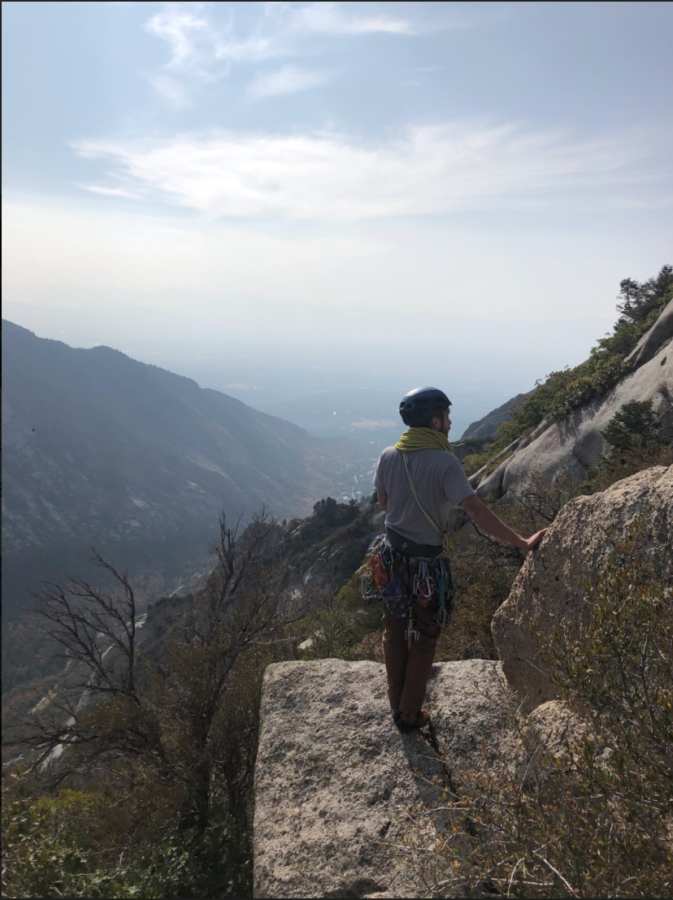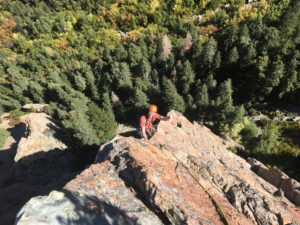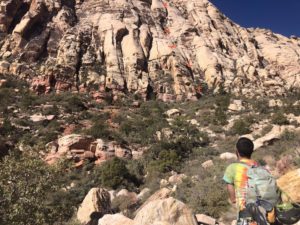My Top 5 Beginner Multi-Pitch Routes (BCC/LCC)
 Your 1st Lead:
Your 1st Lead:
Patty’s Ridge
3-4 pitches — 700 feet! — 5.6
My first time ever trad climbing was also my first time ever leading a trad route. This BCC ridgeline is the perfect introduction for aspiring leaders. The approach takes about 20 minutes and takes you cruising past multiple other great ridgelines within Stairs Gulch. The route is easy, requires some creative anchor building, and is as much ridge scrambles as actual climbing. Patty’s is your easiest way to learn new skills while maintaining a level of safety that can almost guarantee success.
Depending on how you divvy them out, these pitches can end up being quite long. As such, make sure you have either a full rack or are prepared for some moderate run-outs. The climbing is neither technical nor wildly exciting, which actually only furthers Patty’s Ridge as a perfect introduction to Trad. Beyond some easy scree, the descent is pretty mellow and takes you directly back to the base of the climb. Given that this might be your first time out, remember that it’s always better to over-prepare than under-prepare.
https://www.mountainproject.com/route/106267777/pattys-ridge
Ready for Your 1st Run-out:
Steort’s Ridge
3 pitches — 250 feet —5.6
Also located within Stairs Gulch, this uber-popular route is recognized as one of the many classic climbs that grace the Salt Lake Valley. The highlight of this route is unquestionably the third pitch. Following a single bolt, you have the opportunity to either go directly up or traverse around the arete. Around the arete, you will find about 100 feet of exposure with limited opportunities for protection. Creative placements can help mitigate this runout, but you’ll likely face a bit of a mental shake either way.
Beyond this, the route is pretty straightforward and offers solid traditional belay stations throughout. Head out early to avoid getting other groups, as I’ve seen as many as five scattered throughout it at once. Beyond the small scree slope towards the end of the descent, the crucial thing to know surrounds the single rappel. While a 70m rope makes this rappel possible, it leaves an easy, albeit skeezy, 10-15 foot down-climb to reach the trail below.
https://www.mountainproject.com/route/105740006/steorts-ridge
1st Time Leading Crack:
Pentapitch
3-5 pitches — (+/-) 400 feet — 5.8
My first granite lead in LCC, Pentapitch, opened my eyes to what exactly SLC has to offer for climbers. The 5.8 grade is a bit sandbagged, with the final pitch likely being closer to a mid-ranged 5.9. I’d recommend having some experience following a crack climb before heading into this one. The first is easy, but climbs straight through multiple crack systems, while the final pitch requires some thin fingers. Small gear and passive placements are pretty essential throughout. Micros or mid-sized stoppers are especially crucial to protect the crux on the final pitch.
Oddly enough, while the route is named as though it is defined by its five pitches, it can pretty easily be run together into three pitches, allowing for a much more expedited experience. It’s a pretty fun boulder hopping approach, with some clean and easy rappels defining the descent. Additionally, there are a few pitch variations that you can climb, either in place of the standard pitches or following your raps back down to their starts.
https://www.mountainproject.com/route/105739895/pentapitch
1st Time Leading Slab:
School Room (+Direct Variation)
5 pitches — 400 feet — 5.6 or 5.7R depending on the start you choose
As an introduction to slab, this route is about as soft as you can find. Sparsely scattered throughout, this route just introduces you to smearing feet, while still granting you solid handholds. Don’t expect to jump straight from here onto the Super Slab, but at the very least you’ll get a feel for the friction dependent climbing that defines the canyon. The School Room offers some really mellow and easy climbing pretty much the entire way. The upper pitches are all pretty soft but do offer a unique opportunity to try multiple climbing styles in quick succession. Beyond the easy friction slab, you’ll be able to do some traversing, crack climbing, and even grunt your way up what could (very) loosely be termed an off-width section.
The direct variation for Pitch One offers up the sketchiest and most difficult part of the climb. Instead of a long and easy traverse, you climb straight up and make an entirely friction dependent move around a bulge with a ground fall guaranteed if you fall. If that doesn’t sound like fun to you, then … yeah no I mean that would make sense, it’s pretty dumb. It’s also often my favorite part of climbing, which speaks more to the screws I have loose than anything else.
Do your research about the descent before embarking upon this journey, as it can be easy to rappel the wrong direction or miss your station entirely. Once you’re back on the ground the hike down is well defined, and frankly, pretty beautiful. You’ll also be able to watch climbers in the Green Adjective Gulley sending up some really aesthetically interesting trad routes that you can now put on your list for later.
https://www.mountainproject.com/route/105740012/schoolroom
\https://www.mountainproject.com/route/105740036/schoolroom-direct-variation
1st Long Day Leading
Sweet Jane (+Tingey’s)
(+/-) 10 pitches — 950 feet — 5.8
The least beginner route on this list for sure. There are a lot of different ways of going about this route, and you should have possible variations in mind before setting off on this climb. What’s cool with this route is that it can easily be broken into multiple sections that you can bail out of at different points.
The route starts to the right of Beckey’s Wall and can be done in either one or two pitches. It’s some pretty mellow crack climbing, although you need to be confident with your skills and placements throughout the start and end of this section. The top of Pitch Two is your first and best chance to bail out of the climb, as there are chains that can be used to easily rap back down to the ground.
https://www.mountainproject.com/route/105740438/sweet-jane-variation
+ Tingey’s Terror
I had actually even managed to link the third pitch (first pitch of Tingey’s Terror) with the first two by means of a full 70m rope stretch. The “Fourth” pitch of this climb is super mellow and easy to protect but leads up to what is in my opinion the most notable part of the whole climb. You have two options for P5: Continue straight up through some slightly run-out easy slab climbing OR traverse right for about 15 feet through a sea of granite with no protection until coming to the first of three bolts.
This latter option is not for the faint of heart and can be avoided if you have any doubts about your slab climbing abilities. A fall here could be pretty rough, as you’d be swinging directly back into the dihedral. Depending on where you fell, you could be looking at a 30+foot cheese grater slam.
https://www.mountainproject.com/route/105740441/tingeys-terror
+ Tingey’s Torture
Still here for it?! Okay well welcome to the final few pitches of this full-day adventure. These final few pitches are highlighted by some solid run-outs, slabs, and chimneys depending on the routes you end up taking. Beyond a potential 5.10 or silly squeeze chimney variation, the climbing here is a pretty classic 5.8 LCC slab. This is either the perfect or worst way to end a full day of climbing, depending on what you’re into.
https://www.mountainproject.com/route/105740444/tingeys-torture
If you only climb Sweet Jane, the descent is wonderful! Simply rappel back down the way you came, and hike right back out to the parking lot. If you took on the full-day challenge, then you will be doing a bit of wandering to find your way home. You’re in luck if you have climbed and descended from the School Room though, as the actual rappels remain the same. Getting to these rappels however requires a bit of route-finding, unroped scrambling, and snack breaks! Overall, if you do your research it’s not as bad as some folks on the internet make it out to be.




